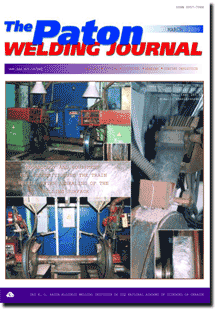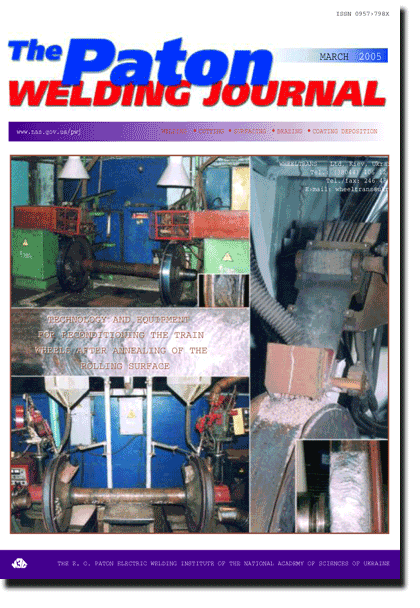

| SCIENTIFIC AND TECHNICAL | |
| Mazurovsky V.L., Zinigrad M.I., Leontiev L.I. and Lisin V.L. Computer-aided design of advanced welding consumables | 2 |
| New approach to design of welding and surfacing consumables, based on modelling of physical-chemical processes occurring at all stages of formation of the weld and its interaction with environment, is described. Phenomenological model of non-equilibrium solidification of the weld pool has been developed, and system for computer-aided design of welding consumables has been built. Example of practical realisation of the new method for design of welding and surfacing consumables is given. | |
| Ponomarev V. and Scotti A. Mechanism of long arc MIG/MAG welding metal transfer mixed modes provoked by inadequate dynamic features of the power source | 7 |
| A mixed metal transfer mode in MIG/MAG welding, in which two or more transfer modes happen in a periodic sequence, is usually undesirable, because it may deteriorate the welding process stability. Thus, there is a strong appeal for investigating the causes of such a metal transfer mode in order to determine means of deal with this phenomenon. This work was aimed to make an experimental and descriptive analysis of the mechanisms that govern one of the free-flight metal transfer mixed mode in the MIG/MAG welding. For that, current rising and falling rates were systematically adjusted in an electronic power supply. The droplet formation and transfer were observed using an arc visualisation system based on a laser and a high-speed camera. The arc voltage and welding current signals were monitored, in synchronism with the droplet images (frames), using a computer-based measuring system. It was verified that one of the factors that provoke this mixed metal transfer mode is inadequate dynamic characteristics of the power source, namely, excessively fast current rising and falling rates that happen during welding circuit resistance changes caused by the metal droplet formation and detachment. The received results seem useful for electronic power source adjustments, as well as for designers of new welding power sources. | |
| Bondarev A.A., Lozovskaya A.V. and Shelenkov G.M. Effect of metallurgical heredity of the AMts alloy semi-finished products on their brazing ability | 13 |
| Chemical composition and structure of materials applied for manufacture of brazed heat exchanges from alloy AMts have been studied. It is shown that defects in parts can be caused by the use of low-quality extruded billets containing oxide films and cavities in cast metal. The latter are located in sub-surface layers of an ingot and transform into extended oxide films and discontinuities during ingot processing. | |
| Arsenyuk V.V., Markashova L.I., Grigorenko G.M., Polovetsky E.V. and Bugaets V.P. Peculiarities of formation of structure of titanium-steel joints under explosion welding conditions | 19 |
| Considered are principles of formation of structure and character of its variation in titanium-steel joints made by explosion welding, as well as factors provoking deterioration of properties of the joints. | |
| Ivakhnenko A.G., Veryovkin M.E. and Ivakhnenko G.A. Study of explosion welding process by combinatorial algorithm of MGAA and data sampling extension | 25 |
| A dependence was studied between the geometrical features of wavy interface of the plates formed in explosion welding on plate location and size, as well as on the amount of the explosive used. The paper also gives the results of studying the properties of the combinatorial algorithm of the method of group accounting for arguments (MGAA) for the posed problem. The model was identified by MGAA combinatorial algorithm, using a data sampling extension. Regularity criterion is used as the main criterion, and minimum displacement criterion is the auxiliary criterion. | |
| INDUSTRIAL | |
| Poznyakov V.D., Kasatkin S.B., Zhdanov S.L. and Strizhak P.A. Features of repair of welded structures from low-alloy steels (Review) | 28 |
| Peculiarities of performing the repair welding operations at reconditioning of metal structures, mechanisms, machines and engineering facilities are reviewed. The paper describes the methods which are the most often used during reconditioning operations of defect repair and groove preparation, repair welding technologies, welding consumables used for repair, and techniques of controlling the welded joints quality. | |
| Ignatchenko P.V. and Bugaj A.I. Some development trends in production of welding consumables and raw material components | 33 |
| Data are given on overall volumes of welding consumable manufacture in CIS countries in 2003, as well as share of their production in Russia and Ukraine. Tendencies of increasing of volumes of small diameter electrode manufacture are noted. Analysis of the available capacities of welding consumable manufacture has been made. | |
| Yavdoshchin I.R., Skorina N.V., Marchenko A.E., Vakolyuk Yu.D. and Paltsevich A.P. New electrodes for welding of carbon and low-alloyed steels | 36 |
| Data are given on new PWI developments in the field of general-purpose coated electrodes with rutile, ilmenite and basic types of coatings. | |
| Dmitrik V.V. and Pritula S.I. Current-carrying nozzles of powder materials for welding torches | 38 |
| Design and powder materials composition of current-carrying nozzles used in CO2 welding torches of semi-automatic and automatic devices and robots are described. It is shown that application of the developed current-carrying nozzles allows their wear to be substantially decreased, stability of the welding process to be raised, and probability of formation of defects in the welds to be reduced. | |
| Kornienko A.N. and Zhadkevich A.M. Problems of quality of braze welded joints and brazing filler metal development (Review) | 41 |
| Trends in development of brazing filler metals, criteria of their selection to produce sound similar and dissimilar joints of products for different engineering fields have been analyzed. Effect of physical properties of the brazing filler metal, specifics of solidification and other factors, which should be taken in to account in development of brazing technologies, on the joint quality, is shown. Promising directions of research in the field of brazing of critical products are outlined. | |
| BRIEF INFORMATION | |
| Lapandin V.D. and Berestovoj A.M. Welded structure of protective fittings of railway tank cars | 47 |
| Design of protective fittings and method for strength analysis, allowing for combined stability of tank car vessel and protective fittings of the stop safety valve system, are proposed. Such a solution makes it possible to maintain performance of the fittings under emergency conditions, when transporting hazardous bulked cargo, and provide environment protection. | |
| Sharapov M.G. and Averianov A.A. Welding on ceramic backings | 48 |
| Examples of efficient application of ceramic backings in welding for construction of tankers and other marine engineering facilities are given. | |
| Korotynsky A.E., Makhlin N.M., Buryak V.G. andKunkin D.D. Universal sensor of electric parameters of welding | 49 |
| Sensor of an electric signal equivalent to measured current or voltage under conditions of increased noise effect is described. Advantages of such devices over traditional sensors of analog signals are shown. Transfer characteristic curves are given, and estimation of the achieved accuracy of the versatile sensor of electrical welding parameters is considered. Ways of enhancement of capabilities of the sensor are indicated. | |
(You are viewing the simplified file contents)
The cost of subscription/purchase order journals or individual articles
| Journal/Currency | Annual Set | 1 issue printed |
1 issue |
one article |
| TPWJ/USD | 384 $ | 32 $ | 26 $ | 13 $ |
| TPWJ/EUR | 348 € | 29 € | 24 € | 12 € |
| TPWJ/UAH | 7200 UAH | 600 UAH | 600 UAH | 280 UAH |
| AS/UAH | 1800 UAH | 300 UAH | 300 UAH | 150 UAH |
| AS/USD | 192 $ | 32 $ | 26 $ | 13 $ |
| AS/EUR | 180 € | 30 € | 25 € | 12 € |
| SEM/UAH | 1200 UAH | 300 UAH | 300 UAH | 150 UAH |
| SEM/USD | 128 $ | 32 $ | 26 $ | 13 $ |
| SEM/EUR | 120 € | 30 € | 25 € | 12 € |
| TDNK/UAH | 1200 UAH | 300 UAH | 300 UAH | 150 UAH |
| TDNK/USD | 128 $ | 32 $ | 26 $ | 13 $ |
| TDNK/EUR | 120 € | 30 € | 25 € | 15 € |
AS = «Automatic Welding» - 6 issues per year;
TPWJ = «PATON WELDING JOURNAL» - 12 issues per year;
SEM = «Electrometallurgy Today» - 4 issues per year;
TDNK = «Technical Diagnostics and Non-Destructive Testing» - 4 issues per year.


